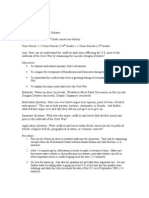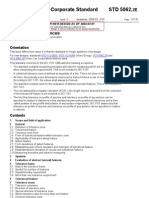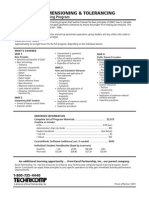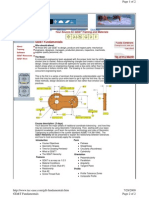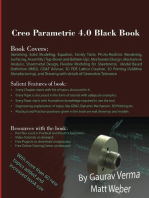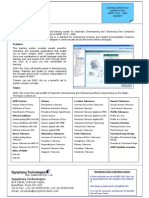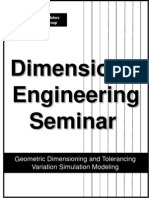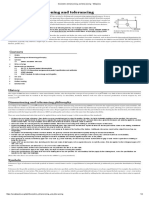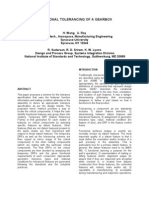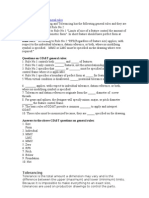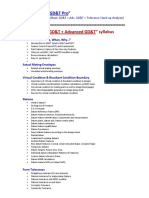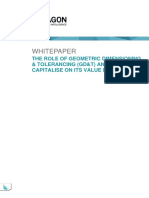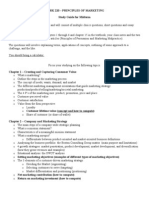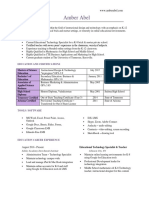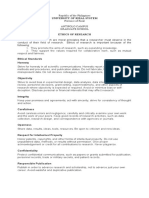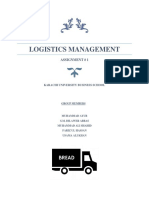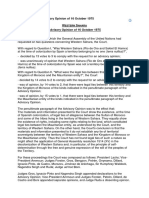25%(4)25% found this document useful (4 votes)
1K viewsAdvanced Concepts of GD&T
Advanced Concepts of GD&T
Uploaded by
Palani TrainerThis course provides an in-depth discussion of advanced GD&T concepts not covered in fundamentals courses. It is intended for engineers with a basic understanding of GD&T. Topics covered include interpreting complex features and feature of sizes, calculating various form tolerances, proper use of datum systems and targets, simultaneous and separate requirements for position and profile tolerances, and definitions of rigid and non-rigid parts. The goal is to help engineers better apply GD&T in complex industrial applications.
Copyright:
© All Rights Reserved
Available Formats
Download as PDF, TXT or read online from Scribd
Advanced Concepts of GD&T
Advanced Concepts of GD&T
Uploaded by
Palani Trainer25%(4)25% found this document useful (4 votes)
1K views3 pagesThis course provides an in-depth discussion of advanced GD&T concepts not covered in fundamentals courses. It is intended for engineers with a basic understanding of GD&T. Topics covered include interpreting complex features and feature of sizes, calculating various form tolerances, proper use of datum systems and targets, simultaneous and separate requirements for position and profile tolerances, and definitions of rigid and non-rigid parts. The goal is to help engineers better apply GD&T in complex industrial applications.
Original Description:
Advanced GDnT
Original Title
Advanced GDnT
Copyright
© © All Rights Reserved
Available Formats
PDF, TXT or read online from Scribd
Share this document
Did you find this document useful?
Is this content inappropriate?
This course provides an in-depth discussion of advanced GD&T concepts not covered in fundamentals courses. It is intended for engineers with a basic understanding of GD&T. Topics covered include interpreting complex features and feature of sizes, calculating various form tolerances, proper use of datum systems and targets, simultaneous and separate requirements for position and profile tolerances, and definitions of rigid and non-rigid parts. The goal is to help engineers better apply GD&T in complex industrial applications.
Copyright:
© All Rights Reserved
Available Formats
Download as PDF, TXT or read online from Scribd
Download as pdf or txt
25%(4)25% found this document useful (4 votes)
1K views3 pagesAdvanced Concepts of GD&T
Advanced Concepts of GD&T
Uploaded by
Palani TrainerThis course provides an in-depth discussion of advanced GD&T concepts not covered in fundamentals courses. It is intended for engineers with a basic understanding of GD&T. Topics covered include interpreting complex features and feature of sizes, calculating various form tolerances, proper use of datum systems and targets, simultaneous and separate requirements for position and profile tolerances, and definitions of rigid and non-rigid parts. The goal is to help engineers better apply GD&T in complex industrial applications.
Copyright:
© All Rights Reserved
Available Formats
Download as PDF, TXT or read online from Scribd
Download as pdf or txt
You are on page 1of 3
Advanced Concepts of GD&T
This course is based on ASME Y14.5 – 2009 Dimensioning and Tolerancing
Standard. It is intended for designers, product engineers, manufacturing and
assembly engineers, and quality engineers. This courseware is for participants
with understanding on fundamental concepts of GD&T.
Advanced concepts include more in depth discussion on selected topics of GD&T
that are not covered in fundamentals of GD&T. The examples included are more
complex and industrial application oriented.
GD&T Fundamentals Review
GD&T skills Pre-requisite survey
GD&T fundamentals for further study
Interpretation of Feature and Feature of Size
Regular, element, complex, and interrupted feature; sub-feature
The terms “opposed,” “fully opposed,” “partially opposed, “size
dimension,” and “cylindrical”
Importance of distinguishing between a feature and feature of size
Requirements and categories of a feature of size
Identifying and interpreting a complete, interrupted, partial, and
bounded feature of size
Form Controls
Calculating the straightness tolerance value with application example
Calculating the flatness tolerance value with application example
Calculating the circularity tolerance value with application example
Calculating the cylindricity tolerance value with application example
The Datum System & Datum Feature Types
Importance and advantages of datum system.
Common misconceptions of datum system.
Common errors in datum usage
Common datum feature types and typical applications
Degrees of freedom restrained when each datum feature type is used
Datum Targets
Applications of datum targets
Specifying fixed and movable datum targets
Special datum target types
Tolerance of Position Usage
Applications of tolerance of position control
Tolerance of position control and material condition used
Simultaneous and Separate Requirements
Simultaneous and separate requirements, effects and where they apply
Tolerance of position at MMC simultaneous requirement
Tolerance of position controls as separate requirements
Composite Position Tolerancing
Rules, advantages, and when to use it
“FRITZ” and “PLTZF”
Tolerance of position composite application
Multiple Single-Segment Tolerance of Position Tolerancing
Rules, advantages, and when to use it
Tolerance of position vs. composite tolerance of position
Conical Tolerance Zones
A conical tolerance zone and advantage of use
Specifying a conical tolerance zone in a tolerance of position application
When to use tolerance of position with a conical tolerance zone
Profile Tolerances
Applications of profile control
Converting coordinate tolerances into profile callouts
The profile datum rule
Profile and Simultaneous Requirements
Simultaneous requirement applied to profile
Profile controls with separate requirements
Composite Profile Tolerancing
Composite profile tolerancing, rules, and advantages
Interpreting a composite profile application
Multiple Single-Segment Profile Tolerancing
Rules, advantages, interpretation, when to use it
Profile vs. a composite profile tolerance
Rigid/Non-Rigid Parts Definitions
Free state
Restrained state
Rigid part
Non-rigid part and part feature
You might also like
- Lincoln-Douglas Debates - Lesson PlanDocument11 pagesLincoln-Douglas Debates - Lesson Planhdivided33% (3)
- Asme 14.5M 2009Document25 pagesAsme 14.5M 2009aguiladezcalza69100% (6)
- GD&T - Application and Interpretation, 6th EditionDocument2 pagesGD&T - Application and Interpretation, 6th Editionmick.pride810% (4)
- Volvo Geometric TolerancesDocument113 pagesVolvo Geometric Tolerancestleomilshaw0% (1)
- Mechanical Design Interview Questions and AnswersDocument16 pagesMechanical Design Interview Questions and Answersarshad khanNo ratings yet
- Tips - Peer Instruction A Users Manual PDFDocument274 pagesTips - Peer Instruction A Users Manual PDFAndrés A's100% (1)
- GD&T CD PDFDocument1 pageGD&T CD PDFYogesh2323No ratings yet
- GD&T Fundamentals: Your Source For GD&T Training and MaterialsDocument33 pagesGD&T Fundamentals: Your Source For GD&T Training and Materialskameron074No ratings yet
- Is My Machine OK?: A Field Guide to Assessing Process MachineryFrom EverandIs My Machine OK?: A Field Guide to Assessing Process MachineryNo ratings yet
- GD&T GlossaryDocument22 pagesGD&T GlossaryPalani TrainerNo ratings yet
- Culture and History by Nick Joaquin Term PaperDocument7 pagesCulture and History by Nick Joaquin Term Papereieipayad25% (4)
- Fundamentals of GD&TDocument7 pagesFundamentals of GD&TPalani TrainerNo ratings yet
- G4 - Advance GD&T and Tolerance Stack-UpDocument9 pagesG4 - Advance GD&T and Tolerance Stack-UpAnkit NaphadeNo ratings yet
- Basics of GD&T - 3 DayDocument3 pagesBasics of GD&T - 3 DayShajil SNo ratings yet
- Geometric Dimensioning & Tolerancing (GD&T) Workshop: Gdt3D 3 Days Related CoursesDocument4 pagesGeometric Dimensioning & Tolerancing (GD&T) Workshop: Gdt3D 3 Days Related CoursesMFNo ratings yet
- Lecture 9 - Symmetry & Concentricity, Expanded Position TolerancingDocument19 pagesLecture 9 - Symmetry & Concentricity, Expanded Position Tolerancingג'ון ירוקNo ratings yet
- Geometric Dimensioning and Toleranincing GD&T: Course Tutor: Peter Benko, PHDDocument4 pagesGeometric Dimensioning and Toleranincing GD&T: Course Tutor: Peter Benko, PHDDiego AzevedoNo ratings yet
- GD&TDocument37 pagesGD&TA ABHISHEK MARSHALLNo ratings yet
- Introduction To GD&T?Document11 pagesIntroduction To GD&T?AravindNo ratings yet
- Local Media5218528843154273693Document12 pagesLocal Media5218528843154273693Kurt Russel Advincula RefugioNo ratings yet
- 2009 GDTDocument4 pages2009 GDTSreejith S NairNo ratings yet
- New GD&TDocument3 pagesNew GD&TvasantNo ratings yet
- GD&T Basics (Level-1)Document85 pagesGD&T Basics (Level-1)Thiyagu rajNo ratings yet
- GDTWizTutor FeaturesheetDocument1 pageGDTWizTutor FeaturesheetkevinjaisNo ratings yet
- Course On GDTDocument3 pagesCourse On GDTPalaniyappan KailasamNo ratings yet
- GDT TutorialDocument76 pagesGDT TutorialVijaysonawane VsNo ratings yet
- Dimensional Engineering SeminarDocument71 pagesDimensional Engineering Seminardramilt100% (4)
- Functional Tolerancing of A Gearbox: January 2003Document9 pagesFunctional Tolerancing of A Gearbox: January 2003Vijet BhandiwadNo ratings yet
- Dimensional Engineering Seminar: Geometric Dimensioning and Tolerancing Variation Simulation ModelingDocument71 pagesDimensional Engineering Seminar: Geometric Dimensioning and Tolerancing Variation Simulation Modelingprasungovindan100% (1)
- Geometric Dimensioning and Tolerancing - WikipediaDocument4 pagesGeometric Dimensioning and Tolerancing - WikipediaEdryle AtanacioNo ratings yet
- Latest Report 2Document13 pagesLatest Report 2Piyush BariNo ratings yet
- Geometric Dimensioning and Tolerancing: Navigation Search Citations Reliable and Independent SourcesDocument8 pagesGeometric Dimensioning and Tolerancing: Navigation Search Citations Reliable and Independent SourcesDeepak LogesonNo ratings yet
- Geometric Dimensioning & Tolerancing (GD&T)Document89 pagesGeometric Dimensioning & Tolerancing (GD&T)Vijay PawarNo ratings yet
- GD&T - Geometric Dimensioning and Tolerancing - Quality-OneDocument7 pagesGD&T - Geometric Dimensioning and Tolerancing - Quality-OneJuan Antonio Canek Cañedo ChavezNo ratings yet
- Dimensional Engineering PDFDocument71 pagesDimensional Engineering PDFAvneet Maan100% (1)
- GD&T 1Document69 pagesGD&T 1JayanthiANo ratings yet
- Converting Design To PrototypeDocument4 pagesConverting Design To PrototypeRrdbjdNo ratings yet
- GD&T12Document136 pagesGD&T12Roshan KhedkarNo ratings yet
- Chapter 8 Requirements DocumentationDocument42 pagesChapter 8 Requirements DocumentationXuen Xuen LeeNo ratings yet
- Geometric Dimensioning and TolerancingDocument4 pagesGeometric Dimensioning and TolerancingAshokNo ratings yet
- GD&T StdsDocument4 pagesGD&T StdsSri PupNo ratings yet
- Report On Dimensional Tolerance: DefinationDocument10 pagesReport On Dimensional Tolerance: DefinationPiyush BariNo ratings yet
- Report On Dimensional Tolerance: DefinationDocument10 pagesReport On Dimensional Tolerance: DefinationPiyush BariNo ratings yet
- Functional Tolerancing of A GearboxDocument8 pagesFunctional Tolerancing of A GearboxHirenkumar Shah100% (4)
- GDT Geometric Dimensioning & Tolerancing Training ASME Y14.5-2009Document8 pagesGDT Geometric Dimensioning & Tolerancing Training ASME Y14.5-2009Giv MeeNo ratings yet
- Profile ToleranceDocument34 pagesProfile ToleranceGopinathNo ratings yet
- GD& T Interview QuestionsDocument3 pagesGD& T Interview Questionsgsgsuresh100% (3)
- GD&T Interview QuestionsDocument2 pagesGD&T Interview Questionskannan saravanan0% (1)
- Collision Experiments To Characterize Collaborative Robots DistrDocument29 pagesCollision Experiments To Characterize Collaborative Robots DistredimazorNo ratings yet
- The Basics of Geometric Dimensioning and Tolerancing (GD&T)Document4 pagesThe Basics of Geometric Dimensioning and Tolerancing (GD&T)rajuhaveriNo ratings yet
- Geometrical Dimensioning and TolerancingDocument51 pagesGeometrical Dimensioning and TolerancingMahender Kumar100% (3)
- Tolerance Variance Analysis WP PDFDocument22 pagesTolerance Variance Analysis WP PDFNirmalan GanapathyNo ratings yet
- Tolerance Variance Analysis WP PDFDocument22 pagesTolerance Variance Analysis WP PDFNirmalan GanapathyNo ratings yet
- (A) "Basics of GD&T + Advanced GD&T" SyllabusDocument4 pages(A) "Basics of GD&T + Advanced GD&T" SyllabusSwapnil GujarathiNo ratings yet
- Geometric Dimensioning and Tolerancing White Paper 2016Document17 pagesGeometric Dimensioning and Tolerancing White Paper 2016Ahdfgb Dbach100% (1)
- Advanced GD&T and Tolerance Stack Up Analysis Workshop by TetrahedronDocument2 pagesAdvanced GD&T and Tolerance Stack Up Analysis Workshop by TetrahedrontetrahedronNo ratings yet
- Linear Dimensions Datum ReferenceDocument4 pagesLinear Dimensions Datum ReferenceVetrivel KanagavelNo ratings yet
- Guidelines For The Use of The C Language in Critical SystemsDocument41 pagesGuidelines For The Use of The C Language in Critical SystemskanibalaNo ratings yet
- Geometric Dimensioning and Tolerancing Workshop by TetrahedronDocument2 pagesGeometric Dimensioning and Tolerancing Workshop by TetrahedrontetrahedronNo ratings yet
- Hafta GD&TDocument68 pagesHafta GD&TgülsümNo ratings yet
- Solar Operated Jib CraneDocument36 pagesSolar Operated Jib CraneJilly Arasu100% (1)
- Asme Y14.43-2003 83Document1 pageAsme Y14.43-2003 83Palani TrainerNo ratings yet
- The Big GD&T Theory: Thomas Allsup Managing Partner Anida TechnologiesDocument56 pagesThe Big GD&T Theory: Thomas Allsup Managing Partner Anida TechnologiesPalani TrainerNo ratings yet
- The Big GD&T Theory: Thomas Allsup Managing Partner Anida TechnologiesDocument56 pagesThe Big GD&T Theory: Thomas Allsup Managing Partner Anida TechnologiesPalani TrainerNo ratings yet
- Chamki WorkDocument1 pageChamki WorkPalani TrainerNo ratings yet
- The Winning WayDocument447 pagesThe Winning WayPalani Trainer100% (4)
- Admas University: Learning GuideDocument15 pagesAdmas University: Learning Guidenigus100% (1)
- The System ApproachDocument2 pagesThe System ApproachMithun JayakumarNo ratings yet
- Spousal Open Work Permit - EditedDocument5 pagesSpousal Open Work Permit - EditedMORRIS ANUNDANo ratings yet
- Resume 01082010Document2 pagesResume 01082010klyethomasNo ratings yet
- An Analysis of The Use of Testimony As A Means of Proof in NigeriaDocument175 pagesAn Analysis of The Use of Testimony As A Means of Proof in NigeriaABDOULIENo ratings yet
- Rising Number of Crimes Against Women Reflects Decay in India's InstitutionsDocument3 pagesRising Number of Crimes Against Women Reflects Decay in India's InstitutionsFunny 666No ratings yet
- MKT Study Guide For MidtermDocument3 pagesMKT Study Guide For MidtermChristina HuNo ratings yet
- Consumer Awareness ProjectDocument16 pagesConsumer Awareness ProjectDrNeeta SinghNo ratings yet
- A Regional Gateway Japanese Popular Culture in Hong Kong 1990-2005 - OtmazginDocument14 pagesA Regional Gateway Japanese Popular Culture in Hong Kong 1990-2005 - Otmazginyeelam wongNo ratings yet
- Week 3 Expressing Thoughts and FeelingsDocument20 pagesWeek 3 Expressing Thoughts and FeelingsPhoebe TanNo ratings yet
- Amber Abel - Resume Portfolio Draft 3Document2 pagesAmber Abel - Resume Portfolio Draft 3api-300591140No ratings yet
- Teacher Learning That Supports Student LearningDocument7 pagesTeacher Learning That Supports Student Learningshe laNo ratings yet
- Business Plan EntrepeneurshipDocument29 pagesBusiness Plan EntrepeneurshipJhay SeresacNo ratings yet
- Banksy BWDocument2 pagesBanksy BWbaibasv100% (1)
- Communications and Electronics Service Regional Communications and Electronics Office O2Document7 pagesCommunications and Electronics Service Regional Communications and Electronics Office O2Vince PrinceNo ratings yet
- RDM Desk ControlDocument11 pagesRDM Desk ControlKenrick Sauquillo Ng ChuiNo ratings yet
- Good Morning EveryoneDocument2 pagesGood Morning EveryoneConclave Dimapur100% (1)
- Pension WorkshopDocument5 pagesPension WorkshopDHIRAJ GUPTANo ratings yet
- Blue Grey ResumeDocument1 pageBlue Grey Resume廿田一No ratings yet
- Syllabus English Core 11Document3 pagesSyllabus English Core 11Prityutpann DeyNo ratings yet
- Ethical Standards Honesty: University of Rizal SystemDocument3 pagesEthical Standards Honesty: University of Rizal Systemhannah goldNo ratings yet
- Art and Architecture FusionDocument12 pagesArt and Architecture FusionMuskan SinghaniaNo ratings yet
- TCW Essay QuizDocument2 pagesTCW Essay QuizLaurence Garcia LaurenteNo ratings yet
- Logistics Management: Assignment # 1Document4 pagesLogistics Management: Assignment # 1Writing HelpNo ratings yet
- Advisory Opinion 1975 Summary WESTERN SAHARADocument6 pagesAdvisory Opinion 1975 Summary WESTERN SAHARAMikee Baliguat TanNo ratings yet
- Basic Principles of Graphics and LayoutDocument17 pagesBasic Principles of Graphics and Layoutedward_sheed28100% (1)
- What Is Inventory TurnoverDocument2 pagesWhat Is Inventory TurnoverDarlene SarcinoNo ratings yet
